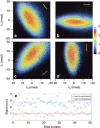Stable femtosecond X-rays with tunable polarization from a laser-driven accelerator
- PMID: 30167214
- PMCID: PMC6062047
- DOI: 10.1038/lsa.2017.86
Stable femtosecond X-rays with tunable polarization from a laser-driven accelerator
Abstract
Technology based on high-peak-power lasers has the potential to provide compact and intense radiation sources for a wide range of innovative applications. In particular, electrons that are accelerated in the wakefield of an intense laser pulse oscillate around the propagation axis and emit X-rays. This betatron source, which essentially reproduces the principle of a synchrotron at the millimeter scale, provides bright radiation with femtosecond duration and high spatial coherence. However, despite its unique features, the usability of the betatron source has been constrained by its poor control and stability. In this article, we demonstrate the reliable production of X-ray beams with tunable polarization. Using ionization-induced injection in a gas mixture, the orbits of the relativistic electrons emitting the radiation are reproducible and controlled. We observe that both the signal and beam profile fluctuations are significantly reduced and that the beam pointing varies by less than a tenth of the beam divergence. The polarization ratio reaches 80%, and the polarization axis can easily be rotated. We anticipate a broad impact of the source, as its unprecedented performance opens the way for new applications.
Keywords: laser-plasma interaction; laser-wakefield acceleration; synchrotron light sources.
Conflict of interest statement
The authors declare no conflict of interest.
Figures





References
-
- Rousse A, Rischel C, Gauthier JC. Femtosecond X-ray crystallography. Rev Mod Phys 2001; 73: 17–31.
-
- McNeil BWJ, Thompson NR. X-ray free-electron lasers. Nat Photonics 2010; 4: 814–821.
-
- Rousse A, Ta Phuoc K, Shah R, Pukhov A, Lefebvre E et al. Production of a keV X-ray beam from synchrotron radiation in relativistic laser-plasma interaction. Phys Rev Lett 2004; 93: 135005. - PubMed
-
- Corde S, Ta Phuoc K, Lambert G, Fitour R, Malka V et al. Femtosecond x rays from laser-plasma accelerators. Rev Mod Phys 2013; 85: 1–48.
-
- Kneip S, McGuffey C, Martins JL, Martins SF, Bellei C et al. Bright spatially coherent synchrotron X-rays from a table-top source. Nat Phys 2010; 6: 980–983.
LinkOut - more resources
Full Text Sources
Other Literature Sources

